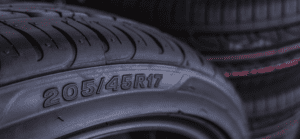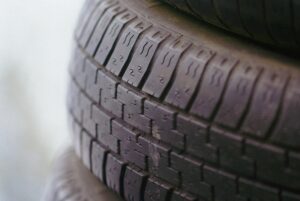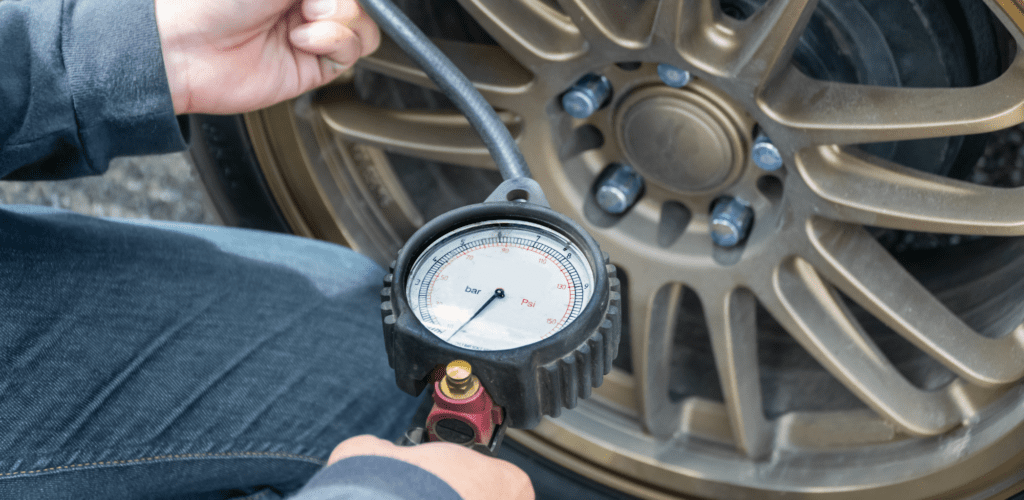
Navigating the maze of car maintenance can often feel daunting for new drivers. Yet, there’s one aspect that stands out for its simplicity and significant impact: tyre pressure.
Understanding and maintaining the right tyre pressure is a small but critical task that can enhance your car’s performance, safety, and efficiency.
Let’s delve into why tyre pressure matters and how you can keep your tyres in top shape.
Why Tyre Pressure Matters
The importance of tyre pressure goes beyond just avoiding a flat tyre. It’s about getting the most out of your vehicle while ensuring that you, your passengers, and other road users are safe. Here’s how:
The Role of Tyre Pressure in Vehicle Safety
The significance of tyre pressure in vehicle safety cannot be overstated. Properly inflated tyres are foundational to your car’s stability, handling, and braking efficiency.
When tyres are at their ideal pressure, they have the optimal contact patch with the road, which is crucial for maintaining control during steering, braking, and accelerating.
Low tyre pressure can lead to a sluggish response from your vehicle during critical moments, such as emergency manoeuvres.
It can also cause overheating in the tyres, increasing the risk of a blowout. Conversely, over-inflated tyres can make your ride uncomfortably bumpy and reduce the tyre’s contact area with the road, making your car more susceptible to skidding or losing control.
Therefore, keeping your tyres correctly inflated is a key component of vehicle safety.
Impact on Fuel Efficiency
Another compelling reason to keep an eye on your tyre pressure is its effect on fuel efficiency. Tyres that are not inflated to the correct pressure level have a higher rolling resistance—the force that opposes the motion when an object rolls on a surface.
Lower rolling resistance means your car doesn’t have to work as hard (or consume as much fuel) to move forward, which not only saves you money at the fuel pump but also reduces your car’s environmental impact.
In short, correct tyre pressure is both economically and environmentally beneficial.
Enhancing Tyre Life and Performance
Lastly, maintaining the right tyre pressure is crucial for ensuring your tyres last as long as possible and perform optimally under various driving conditions.
Over or under-inflated tyres can lead to uneven wear patterns, significantly reducing the lifespan of your tyres and necessitating more frequent replacements.
This not only affects your wallet but can also lead to suboptimal performance, such as reduced grip on the road surface.
Correct tyre pressure helps ensure that tyres wear evenly, extending their life and maintaining better performance, whether you’re cruising on the highway or navigating through wet conditions.
Understanding Tyre Pressure
Knowing how to manage your car’s tyre pressure is a skill every driver should have in their arsenal. But to do this effectively, it’s essential to understand what the right tyre pressure is for your vehicle and how various factors can influence it. Let’s break it down:
What is the Right Tyre Pressure?
The right tyre pressure for your vehicle is not a one-size-fits-all figure. It’s determined by the vehicle manufacturer and takes into account the tyre size, type, and the vehicle’s weight.
This meticulous calculation ensures that your tyres are inflated to provide optimal performance, safety, and fuel efficiency.
So, where do you find this gold standard for your tyres? The recommended tyre pressure levels are typically listed in your owner’s manual and on a sticker located in the doorjamb on the driver’s side.
This sticker might also be found inside the fuel hatch. It’s worth noting that there might be different recommendations for the front and rear tyres, especially in vehicles that carry heavier loads or tow trailers.
How to Read Tyre Pressure Measurements
Tyre pressure is commonly measured in Pounds per Square Inch (PSI) or bar, with 1 bar being roughly equivalent to 14.5 PSI.
When you use a tyre pressure gauge or a pump with a digital readout, you’ll see the pressure displayed in one of these units.
It’s crucial to check the tyre pressure when the tyres are cold – that is, when the vehicle has been stationary for a few hours or hasn’t been driven for more than a couple of miles.
This provides an accurate reading because as tyres warm up from driving, the pressure inside them increases, potentially giving a misleading higher pressure reading if checked immediately after driving.
Factors Affecting Tyre Pressure
Several external factors can influence your car’s tyre pressure, leading to fluctuations that may require adjustments:
-
Temperature changes are the most common cause of altered tyre pressure. As the ambient temperature drops, so does the pressure in your tyres, and vice versa. This is why it’s especially important to check tyre pressure with the change of seasons or before setting out on a long trip in different weather conditions.
-
Altitude can also play a role. Higher altitudes tend to lower tyre pressure, although the effect might be less noticeable unless you’re frequently driving in significantly varied altitudes.
-
Typical load conditions should be considered as well. If you’re planning to drive with a heavier load than usual or tow a trailer, you might need to adjust your tyre pressure according to the manufacturer’s recommendations for such conditions.
Understanding and managing your vehicle’s tyre pressure might seem like a minor detail, but it’s a critical component of car maintenance that can significantly affect your driving experience, safety, and the economy of your vehicle.
Regular checks and adjustments ensure that your tyres are set up to deliver their best performance, regardless of the conditions you face on the road.
Checking Your Tyre Pressure
Regularly checking your tyre pressure is a simple yet crucial part of vehicle maintenance that can greatly affect your car’s efficiency, safety, and the longevity of your tyres.
Let’s explore the tools you’ll need and a step-by-step guide to ensure you’re doing it correctly.
Tools You’ll Need
To check your tyre pressure, you’ll need a few basic tools:
- Tyre Pressure Gauge: This is the most important tool for checking your tyre pressure. They come in digital, dial, and stick types. Digital gauges are known for their accuracy and ease of reading.
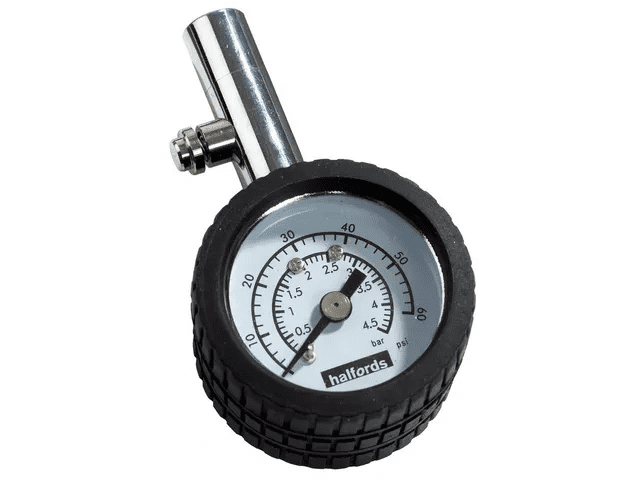
- Air Compressor or Pump: While not necessary for checking the pressure, you’ll need access to an air compressor to inflate your tyres if they’re low. Most service stations have them available, often with a built-in gauge to check pressure as you inflate.
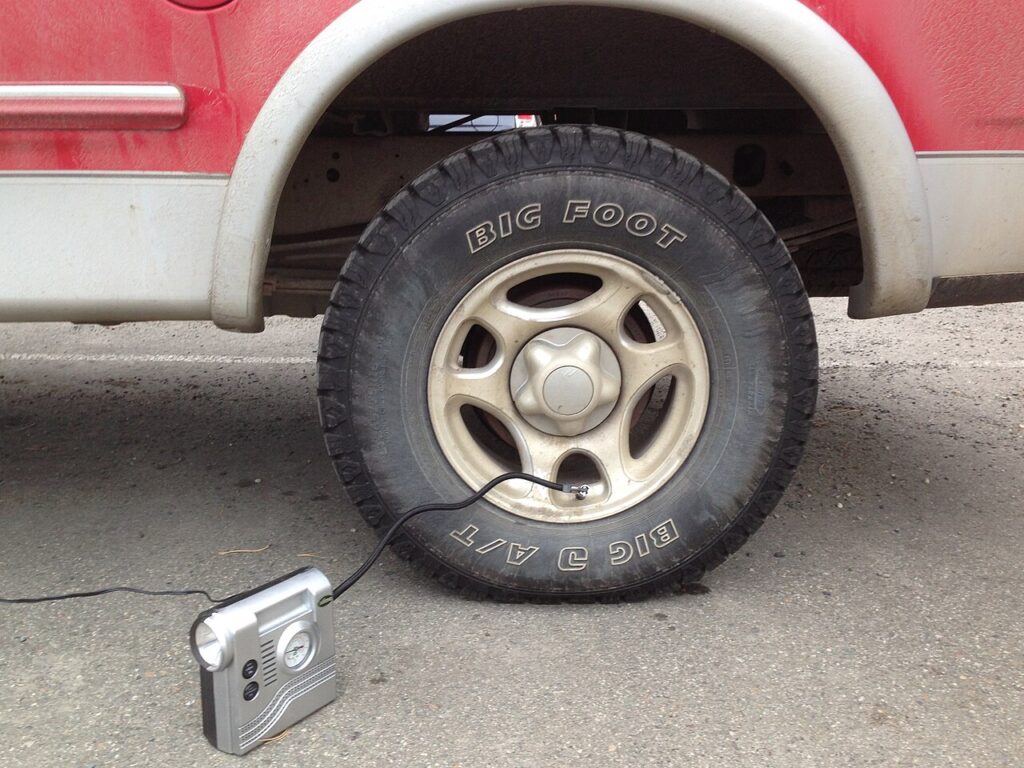
Step-by-Step Guide to Checking Pressure
Checking your tyre pressure is a straightforward process. Follow these steps for accurate results:
-
Find the Recommended Pressure: Before you do anything else, make sure you know the recommended tyre pressure for your vehicle. Check your owner’s manual or the sticker in the doorjamb for this information.
-
Check When Tyres are Cold: For the most accurate reading, check your tyre pressure when the tyres are cold. This means either before you’ve driven for the day or at least three hours after you’ve driven.
-
Remove the Valve Cap: Each tyre has a valve stem on the side of the tyre. Remove the cap from this valve stem. Keep it in a safe place while you check the pressure; these caps are small and easy to lose.
-
Press the Gauge onto the Valve Stem: Take your tyre pressure gauge and press it firmly onto the valve stem. If you’re using a digital or dial gauge, you should get a reading almost instantly. If you’re using a stick gauge, the pressure will push a small bar out from the bottom of the gauge, giving you the pressure reading.
-
Read the Measurement: Note the pressure reading on the gauge. Compare this with the recommended pressure for your tyres. If the number is lower than the recommendation, you’ll need to add air. If it’s higher, you’ll need to let some air out.
-
Adjust the Pressure if Necessary: Use an air compressor to adjust the pressure. If you’re at a service station, you can usually set the desired pressure on the machine, and it will automatically stop when that pressure is reached.
-
Replace the Valve Caps: Once you’ve checked and adjusted the pressure in all your tyres, don’t forget to replace the valve caps. These caps protect the valve from dirt and moisture.
How Often Should You Check?
For optimal performance and safety, it’s recommended to check your tyre pressure at least once a month and before any long trips.
It’s also wise to check before and after carrying an extra load. Regular checks can help you spot a slow leak before it becomes a bigger problem and ensure that your tyres are always in the best condition for driving.
By following these steps and maintaining the correct tyre pressure, you’re not just ensuring a smoother ride; you’re also contributing to the safety, efficiency, and durability of your vehicle.
Adjusting Your Tyre Pressure
Maintaining the correct tyre pressure is not just about checking it regularly; it’s also about making the necessary adjustments to ensure that your tyres are neither over- nor under-inflated.
Here’s how to inflate your tyres to the recommended pressure and correct them if they are over-inflated.
How to Inflate Your Tyres
Inflating your tyres is a straightforward process, especially if you’re using the public air compressors found at many petrol stations:
-
Find a Petrol Station with an Air Compressor: Most petrol stations have an air compressor that’s either free or coin-operated.
-
Remove the Valve Caps: Before you start, remove the valve caps from your tyres and keep them in a safe place.
-
Check the Current Tyre Pressure: Use your tyre pressure gauge to check the current pressure of your tyres.
-
Set the Compressor to the Recommended Pressure: Many modern air compressors allow you to set the desired pressure beforehand. If the compressor at your station has this feature, input the recommended pressure for your tyres.
-
Inflate the Tyres: Attach the compressor nozzle to the tyre’s valve stem. If you’ve set a specific pressure, the machine will automatically stop once that pressure is reached. If not, you’ll need to check the pressure manually during inflation to ensure you don’t over-inflate.
-
Recheck the Pressure: After inflating, use your gauge to check the tyre pressure again to ensure it’s correct.
-
Replace the Valve Caps: Don’t forget to replace the valve caps on your tyres once you’re done.
Correcting Over-Inflated Tyres
If you find that your tyres are over-inflated, you’ll need to let some air out until you reach the recommended pressure:
-
Press the Valve Stem: Use the back of your tyre gauge or another small tool to gently press on the valve stem. This will release some air from the tyre.
-
Check the Pressure Periodically: Periodically check the pressure by removing the tool and using your gauge. It’s better to check frequently and release air in short bursts to avoid letting out too much.
-
Adjust as Necessary: Continue to release air and check the pressure until you reach the desired level.
Tips for Maintaining Optimal Pressure
To keep your tyres at the right pressure consistently, consider the following best practices:
-
Regular Checks: Make it a habit to check your tyre pressure at least once a month and before any significant journey. Regular checks can help you maintain optimal tyre pressure and identify any issues early.
-
Use Quality Air Pumps: Investing in a good quality tyre pressure gauge and a portable air pump can save you a lot of time and hassle, especially if you frequently need to adjust your tyre pressure.
-
Consider Tyre Sealants for Minor Puncture Repairs: For minor punctures, a tyre sealant can be a quick fix that allows you to keep driving until you can get the tyre repaired or replaced. However, it’s important to use these products as a temporary solution and not a substitute for proper tyre maintenance.
Maintaining the correct tyre pressure is a simple yet crucial aspect of car maintenance that significantly impacts your vehicle’s performance, safety, and fuel efficiency.
By following these steps and tips, you can ensure that your tyres are always in top condition, providing you with a smoother, safer ride.
Seasonal and Load Adjustments
Changes in weather and the weight of your vehicle can significantly impact tyre pressure, necessitating adjustments to ensure your tyres are performing optimally.
Here’s how to adjust tyre pressure for different weather conditions and loads.
Adjusting Pressure for Weather Conditions
The air inside your tyres expands when heated and contracts when cooled. Therefore, extreme temperatures can lead to significant changes in tyre pressure:
-
Hot Weather: In warmer months, the air inside the tyre can expand, potentially causing over-inflation if not monitored. It’s crucial to check tyre pressure early in the morning before temperatures rise. You may need to release some air to maintain the recommended pressure levels.
-
Cold Weather: During colder months, tyre pressure can drop as the air inside the tyre contracts. This may require you to add air to your tyres to reach the optimal pressure. Regular checks are important, especially during sudden cold snaps, to ensure your tyres are not under-inflated.
Tyre Pressure When Carrying Heavy Loads
When your vehicle is heavily loaded, whether it’s with passengers, luggage, or both, the tyres are subjected to additional stress. This can impact their performance and increase wear if the tyre pressure is not correctly adjusted:
-
Increase Tyre Pressure: It’s often necessary to increase tyre pressure when carrying heavy loads to help the tyre support the extra weight more effectively. This adjustment helps maintain stability, improve handling, and prevent the tyre from overheating.
-
Consult Your Vehicle’s Manual: The recommended adjustments for different load conditions are usually provided in your vehicle’s manual. This information might also be on the tyre placard in the doorjamb. These adjustments ensure that your tyres can handle the extra load without compromising on safety or performance.
Special Considerations for Long Trips
Long-distance driving poses additional considerations for tyre pressure due to increased load and sustained high speeds:
-
Check and Adjust Before You Leave: Before embarking on a long journey, check your tyre pressure and adjust it according to the load you’ll be carrying. It’s also wise to consider the weather conditions you’ll be driving in and adjust accordingly.
-
Monitor Tyre Pressure During the Trip: Long trips can lead to changes in tyre pressure, especially with significant temperature variations. Monitor the pressure at stops along your route and adjust as needed to ensure it remains at the optimal level.
-
Extra Caution for High Speeds: Sustained high speeds can increase tyre temperature and pressure. If you’re planning to drive at high speeds for extended periods, check your tyre pressure regularly to ensure it does not exceed the recommended maximum.
Adjusting tyre pressure for seasonal changes and load conditions is a vital aspect of tyre maintenance.
It ensures that your tyres remain in good condition, providing you with better fuel efficiency, safety, and handling, regardless of the driving conditions.
By paying attention to these adjustments, you can help extend the life of your tyres and enjoy a safer, more comfortable driving experience.
Troubleshooting and Maintenance
Ensuring your tyres are properly maintained and promptly addressing any issues can significantly enhance your driving experience, safety, and the longevity of your tyres.
Here’s how to recognise the symptoms of incorrect tyre pressure, deal with a flat tyre, and maintain your tyres regularly.
Recognising Symptoms of Incorrect Tyre Pressure
Incorrect tyre pressure can lead to several noticeable issues with your vehicle:
- Uneven Tyre Wear: This is a common sign of incorrect tyre pressure. Over-inflated tyres tend to wear more in the middle, while under-inflated tyres wear more on the edges.
- Decreased Fuel Efficiency: If you’re noticing that your car is consuming more fuel than usual, it could be due to under-inflated tyres increasing rolling resistance.
- Poor Handling: Incorrect tyre pressure can affect your car’s handling, making it feel sluggish or overly stiff. Under-inflated tyres might make the vehicle seem unresponsive, while over-inflated tyres can lead to a harsher ride.
Dealing with a Flat Tyre
A flat tyre can be a significant inconvenience, but handling it safely is crucial:
- Safe Pullover Practices: If you suspect you have a flat tyre, don’t brake abruptly or make sharp turns. Slow down gradually and look for a safe, flat area to pull over, away from traffic.
- Using a Spare Tyre or Tyre Repair Kit: If you have a spare tyre, replace the flat tyre following the instructions in your vehicle’s manual. If you have a tyre repair kit, follow the kit’s instructions carefully. These are temporary solutions, so be sure to seek professional tyre repair or replacement as soon as possible.
- Seeking Professional Help: If you’re not comfortable changing the tyre yourself, or if you don’t have the necessary equipment, it’s best to call for roadside assistance or a professional tyre service.
Regular Maintenance Tips
Regular tyre maintenance can extend the life of your tyres and improve your vehicle’s performance:
- Routine Inspections: Regularly check your tyres for signs of wear and tear, including cracks, bulges, or objects lodged in the tread. Early detection of these issues can prevent further damage.
- Alignment Checks: Misaligned wheels can cause uneven tyre wear and affect your vehicle’s handling. Have your alignment checked by a professional if you notice uneven wear patterns or if your vehicle pulls to one side.
- Balancing: Tyres should be balanced when they are mounted on the wheels. Unbalanced tyres can lead to vibration, excessive tyre wear, and strain on the vehicle’s suspension. Have your tyres balanced regularly, especially if you notice any unusual vibration.
By adhering to these troubleshooting and maintenance tips, you can ensure that your tyres remain in good condition, enhancing your driving experience, improving safety, and extending the lifespan of your tyres.
Regular checks and maintenance are small investments that can lead to significant savings and peace of mind in the long run.
Frequently asked questions
It’s recommended to check your tyre pressure at least once a month and before long trips or when carrying an extra load.
The correct tyre pressure for your car is specified by the vehicle manufacturer and can usually be found in the owner’s manual or on a sticker in the doorjamb on the driver’s side.
No, you should use the pressure recommended by the vehicle manufacturer rather than the maximum pressure listed on the tyre. The manufacturer’s recommendation is based on optimal performance and safety for your specific vehicle.
Tyre pressure decreases in colder temperatures and increases in warmer temperatures.
It’s important to check and adjust your tyre pressure with significant temperature changes.
Over-inflating tyres can lead to a harsher ride, reduced traction, and uneven tyre wear, primarily in the centre of the tread.
Under-inflated tyres can cause sluggish handling, increased fuel consumption, and uneven wear, particularly on the edges of the tread.
It also increases the risk of tyre overheating and blowouts.
Uneven wear can appear as excessive wear on one edge of the tyre, in the centre, or as patches of irregular wear. Regular inspections can help spot these issues early.
Gradually slow down and pull over to a safe, flat location.
Replace the flat tyre with your spare or use a tyre repair kit if you’re equipped and comfortable doing so. Otherwise, call for roadside assistance.
Yes, you may need to adjust your tyre pressure for long trips, especially if you’re carrying additional passengers or heavy loads. Check your vehicle’s manual for guidance on adjustments.
Signs that your tyres may need balancing include vibrations in the steering wheel or seat at certain speeds. If your vehicle pulls to one side or you notice uneven tyre wear, it may need an alignment check.

